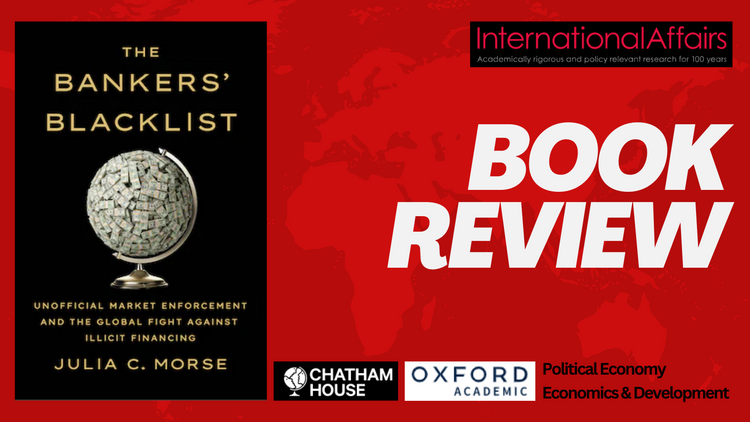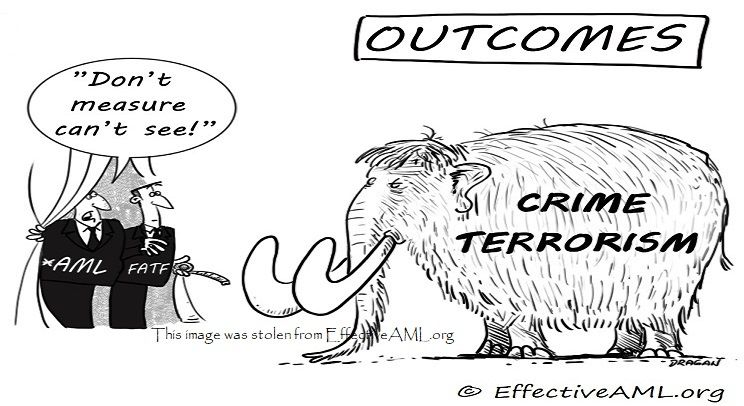About that first story, and future possibilities

If The Onion – a satirical news publication – ran the opening story, it would expose only the negative side of the slow-moving train wreck of the modern anti-money laundering movement. A future article will outline what FATF has done well. It might surprise you.
After The Economist, Forbes and others based articles on my research about anti-money laundering’s effectiveness deficit, it is worth reflecting on what The Economist missed. (Clue: Even great journalists fall into huge orthodoxy traps. Like hiking through Yellowstone Park without a geologist it is virtually impossible to see that you are inside the caldera of a super volcano).
Why does outcomes science matter in AML? A common refrain is that it works because we rescue trafficked people, and catch drug traffickers. We just need to double our efforts. The problem with that thinking is that if there's 1,000 victims and 1,000 criminals, rescuing one and locking up one, and doubling our efforts for two, ignores a rethink and reset to rescue 400 and lock up 400, the real impact on crime intended by G7 leaders before anti-money laundering became an ideology, blind to police science and outcomes science.
- The system is so profoundly ineffective that, willfully blind and refusing to countenance reality, AML arguably protects, enables, and supports sex-, human-, wildlife- and drug-traffickers, fraudsters, corrupt officials, and tax evaders on a global scale. UN (2011), Pol (2018, 2020).
- AML causes immense harm, both from the harm it fails to prevent, and the immense harm it causes, to millions of people, communities, businesses, and countries. Pol (2019, 2020a, 2020b), UN (2021).
- AML marked by constantly rising regulatory risk and escalating compliance costs, on a scale and magnitude possibly unprecedented in the history of regulatory compliance (Pol, 2020).
- The astonishing scale of unnecessary costs create massive barriers to entry, locking out countless new firms from offering better, cheaper, more innovative financial services.
- Extending AML rules to other industries – like cryptocurrencies, blockchain, and decentralized finance – without addressing fundamental problems, expand the cancer of laws so badly designed that I have been quoted in US Senate testimony describing AML as arguably the least effective anti-crime intervention, ever, anywhere. Simplistic “crypto bad, AML good” narratives despite shared objectives (no-one wants crime) chill meaningful debate and risk one-size-fits-all regulations (and failure, harm, and spiraling costs) rather than smarter, effective, solutions.
This site will feature obstacles to better outcomes and curious forks in the road of history. (For example, a fundamental design flaw – triggered by three ambiguous words – may have been influenced by a curious turn of events on a warm Sunday, in Paris, with officials and world leaders distracted by dancing bears).
If there is enough interest in AML effectiveness, future stories may address:
- When, how, where, and why the AML juggernaut veered off track.
- Bigger than Watergate: The untold story about AML should deliver Pulitzer Prizes, Peabody Awards, and European Press Prizes.
- Contrary to the status quo, better outcomes do not need more data, more compliance, more “unintended” consequences, escalating regulatory risk, and exponential costs. The reverse is true.
- What are “outcomes” anyway? What is the established science that AML orthodoxy appears resolutely to ignore, and why does it matter?
- For journalists: NAB, TSB, and countless other “AML breach” stories. Two questions, unasked, expose the harsh reality behind the official narrative flawlessly managed (the first loose threads are just starting to appear).
- For bank boards: Hidden in plain sight. Two things to look for in board papers to know if your bank is an open invitation to regulators, or not. (Clue: It is not what CROs tell you, it is what they don’t).
- For bank CEOs: Tired of virtue signaling in response to regulators’ virtue signaling? It is now possible to demonstrate what regulators demand, and what they say they want, side-by-side. There is no need to rail against or change the system, when regulators themselves choose the option that cuts your regulatory risk and compliance costs. (Tellingly, of hundreds of AML compliance systems I've examined or scanned over the years, none seems capable of making that leap. Like the “developed by NASA" tech we use everyday, the first I've seen to do this seamlessly was built outside AML's siloed thinking tent).
- For Police chiefs: Three interview questions for financial crime and asset recovery roles that separate applicants who tick all the boxes but won’t move the dial from those enabling a transformative impact on serious profit-motivated crime and other financially indicated crime, including terrorism.
- For FIU heads: This performance measure reveals if your team manages data haystacks or has the capacity to proactively slash serious profit-motivated crime.
- The United Nations (rightly) slammed the global AML system for the second time in a decade – for being almost completely ineffective and causing massive harm – but stops short. How the UN proposal patches up symptoms but does nothing to stop the harm continuing.
- What makes you right when “nearly everyone” believes something else? It is not about me. Nor is it rocket science. I just kept asking questions. Facts are facts. Anyone can discover them by doing the same, and unpack assumptions, beliefs, and narrative. Irrespective what anyone says, it is easy to repeat what seems plausible, or to question it and make sure it stacks up. Questions reveal facts and evidence that already exists.
- Has another decade of failure just been locked in? FATF, the EU and GFI appear to have locked in a record fourth decade of anti-money laundering failure.
- What are the two likely future options as the AML juggernaut approaches the natural end result built into the design of the modern anti-money laundering experiment, #zeroimpactinfinitecost.
- Three metrics enabling transformational impact, which no AML system even measures.
- Metrics that matter: For bank, police, and country leaders. Some anti-money laundering metrics perpetuate failure, others enable success.
- AI is not the solution: How AI is used is critical, but AI tuned for outcomes is vanishingly rare.
- Anecdote vs evidence: A steady stream of success stories obscures the bigger picture: stage-managed, high-profile arrests deliver click-bait appeal and the perception of progress, and some criminals are caught, yet Criminals Inc thrives.
- Myths and nonsense: Why beneficial ownership transparency, international co-operation, data sharing, more commitment by governments, more resources for regulators, penalizing banks and countries more, are not silver bullets. What history and science tells us, and why nearly every silver bullet “solution” fails, due to one key design quirk.
- Upside down land: Is AML software the only software "solution" that pushes easy work to staff rather than let computers deal with it? It sure makes risk and cost escalate, fast.
- Upside down land: 98 percent false positive rates is “normal”, really? AML orthodoxy uses software, and people, backwards.
- Upside down land: Do you have AML backlogs? You’re using AML software the way it was designed, badly. Clear backlogs – and cut risks, and costs – by using software smarter, not harder.
- Oxymoron: Anti-money laundering, AML education, and more.
- The “financial crime” misnomer: If you really want to be effective, why you might want to reconsider job titles, section names, and mission statements about fighting “financial crime”.
- Flip the narrative, to cut crime, risk, and costs: It is now possible for any country, or bank, to break free from today’s negative-sum game, today, risk free. The problem is no longer feasibility, it is vision, and overcoming obstacles. Those obstacles are manifold, yet readily surmountable when revealed. So, a segment we call obstacles will briefly outline a slew of them. (The vision for leadership bit is in your camp).
If I am wrong and there remains scant interest in what AML effectiveness really means (a distinct possibility, based on the past 32 years), the third (current) round of “effectiveness angst” in three decades appears set to follow its predecessors. Just like in 1989-1990 and (especially) 2010-2012, there is again lots of talk loosely using the language of “effectiveness” and “outcomes” without much discernible connection with established, proven, practical methods for enabling intended outcomes.
But I am optimistic.
Anti-money laundering may be the only major policy endeavor with few connections with effectiveness and outcomes science but, for the first time in over 30 years, there seems a scintilla of interest, and growing recognition that using the words “effectiveness” and “outcomes” does not make it so, and that “hype and hope” is not a strategy.
The anti-money laundering narrative, however, is so pervasive, and self-defeating, that scientists have found it impossible to simply lay out prospective solutions. Nothing survives the scorched earth of anti-money laundering orthodoxy.
To reorient for effectiveness, we must first face reality, frankly.
This site seeks to move some blackened stumps of calcified thinking and clear a few embers of unproven assumptions and belief – while hopefully avoiding some of the fires of raging dogma – to help clear a landing strip for new ideas.
[And a few mangled metaphors].
More importantly, perhaps, the latest research suggests that pathways to effectiveness no longer need to be top-down.
For the first time, it may be possible for leaders in individual banks, law enforcement agencies, and countries to start turning the tide, without first having to change the system. To tick the boxes while also moving the dial. With success, measured objectively and robustly – with metrics that matter – others may follow, not because they are forced to, but because it works. “The system” can catch-up, and might once again lead for outcomes, as G7 leaders’ intended over 30 years ago.
If you want compliance tips, this site is not for you.
It is for those interested in transformational impact, and leadership for outcomes, from coalface to boardroom.
Whether change is top-down or bottom-up, this site is about strategy with impact – and may be the first and only site focused on AML effectiveness, curated by someone with a PhD in AML effectiveness.
That is no boast. Frankly, it is tragic. Joining anti-money laundering practice with proven and practical ways to achieve intended outcomes remains vanishingly rare.
But outcomes science is not rocket science.
Some people collect university qualifications like a sport, but other great thinkers have no degrees – nor even (tellingly, perhaps) the omnipresent online short-course anti-money laundering certificate.
The key skill is critical thinking.
The main talent, curiosity.
The only prerequisite is an aptitude to question assumptions and beliefs, sometimes even our own.
The only goal is enabling substantially better outcomes – beyond hype, rhetoric, and bullshit.
(on that front, a substantial, demonstrable impact on crime should involve fewer "unintended" consequences, less compliance, less regulatory risk, and less compliance costs – not more).
If that sounds like you, this site is for you.
Sign up, buckle up, and help kickstart a real conversation about effectiveness.


